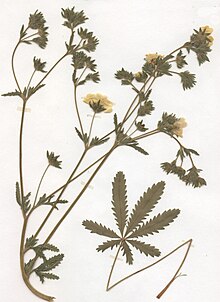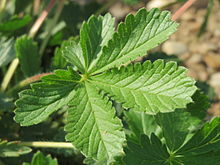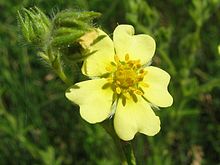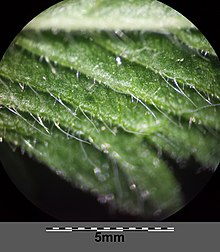High cinquefoil
| High cinquefoil | ||||||||||||
|---|---|---|---|---|---|---|---|---|---|---|---|---|

High cinquefoil ( Potentilla recta ) |
||||||||||||
| Systematics | ||||||||||||
|
||||||||||||
| Scientific name | ||||||||||||
| Potentilla recta | ||||||||||||
| L. |
The high cinquefoil ( Potentilla recta ), also called erect cinquefoil , is a species of cinquefoil ( Potentilla ) within the rose family (Rosaceae). It is widespread in Eurasia and northwestern Africa.
description
Appearance and leaf
The high cinquefoil grows as a perennial herbaceous plant and reaches heights of 20 to 80 centimeters. The usually stiff upright stem is leafy and branches out in the upper area. The stem is long-haired loosely to closely spaced apart, with very short bristle hairs in between and glandular hairs in the upper part.
The alternate leaves are arranged in a petiole and a leaf blade. The fingered leaf blade has five to seven leaflets. The leaflets are at a length of 3 to 8cm-inverted lanceolate to ovate and vigorously until almost sawn fiederspaltig. The leaflets are more or less dense and hairy long, but never tomentose. There are stipules present.
Generative characteristics
The flowering period extends from May to September. A terminal, rich and loosely-flowered, paniculate inflorescence is formed.
The hermaphrodite flowers are radially symmetrical and five-fold with a diameter of 20 to 25 millimeters . The five outer sepals are lanceolate and 7 to 8 millimeters long; they enlarge later to 10 to 12 millimeters and are slightly longer than the sepals. The five sepals are triangular-ovate and pointed. The five pale yellow to golden yellow petals are heart-shaped.
Usually more than 100 wrinkled fruits are formed.
Chromosome number
The number of chromosomes is 2n = 28, 35 or 42.
Occurrence and ecology
The original distribution area of Potentilla recta is probably Southeast Europe , Southwest to Central Asia . The current distribution area extends in Europe to the west to Spain, to the north to southern Scandinavia, in the south to the whole of the Mediterranean, including northwestern Africa, Anatolia and Iran . The cinquefoil is an east Mediterranean-continental floral element and is evidently still spreading further in west, central and northern Europe. The high cinquefoil is found scattered in Central Europe .
The high cinquefoil occurs very scattered throughout Germany; in many cases it is a rather rare adventitious plant . In the Allgäu Alps, it rises in the Tyrolean part below the valley station of the Jöchelspitze cable car near Bach to an altitude of 1220 meters.
The cinquefoil is apparently still spreading, whereby the spread of the fruits with seeds and forest and ornamental plants, as well as the overgrowth from gardens play a role. The fruits are spread either by the wind or by animals.
The cinquefoil grows in dry, base-rich locations, for example in ruderal grass areas, in pioneering corridors on flood and railway embankments, bank and road embankments, in parks, gravel pits. In Central Europe it thrives in societies of the Sedo-Scleranthetea class, but also in those of the Festuco-Brometea class or the Arction association.
Systematics
The first publication of Potentilla recta was in 1753 by Carl von Linné .

The species Potentilla recta is rich in shape in terms of the perforation of the leaflets, the density of the hairs and the color of the flowers. Overall, the subdivision of the species has not yet been processed satisfactorily. Usually the cinquefoil ( Potentilla recta ) is divided into four subspecies, of which the Potentilla recta subsp. recta and the potentilla recta subsp. obscura should be mentioned. These differ in the flower color (pale yellow in the Potentilla recta ssp. Recta , intense yellow in the Potentilla recta subsp. Obscura ), as well as in the shape of the leaflets (broadest in the middle in the Potentilla recta subsp. Recta , im anterior third broadest at the potentilla recta subsp. obscura ).
In Europe and the Mediterranean, the following subspecies are recognized:
- Potentilla recta L. subsp. recta
- Potentilla recta subsp. afra (Pau & Font Quer) Romo : It occurs in Morocco.
- Potentilla recta subsp. crassa (Opiz) Rothm. : It occurs in the Czech Republic, Slovakia and Hungary.
- Potentilla recta subsp. laciniosa (Nestl.) Nyman
- Potentilla recta subsp. leucotricha (Borbás) Goliašová : It occurs on the Balkan Peninsula, in Hungary and in Slovakia.
- Potentilla recta subsp. obscura (Willd.) Arcang.
- Potentilla recta subsp. pilosa (Poir.) Jáv.
literature
- Henning Haeupler, Thomas Muer: picture atlas of the fern and flowering plants of Germany . Ed .: Federal Agency for Nature Conservation (= The fern and flowering plants of Germany . Volume 2 ). Eugen Ulmer, Stuttgart (Hohenheim) 2000, ISBN 3-8001-3364-4 .
- Wolfgang Adler, Karl Oswald, Raimund Fischer: Excursion flora of Austria . Ed .: Manfred A. Fischer. Eugen Ulmer, Stuttgart / Vienna 1994, ISBN 3-8001-3461-6 .
- Christian Heitz: School and excursion flora for Switzerland. Taking into account the border areas. Identification book for wild growing vascular plants . Founded by August Binz. 18th completely revised and expanded edition. Schwabe & Co., Basel 1986, ISBN 3-7965-0832-4 .
- Erich Oberdorfer : Plant-sociological excursion flora . With the collaboration of Theo Müller. 6th, revised and expanded edition. Eugen Ulmer, Stuttgart (Hohenheim) 1990, ISBN 3-8001-3454-3 .
- Konrad von Weihe (ed.): Illustrated flora. Germany and neighboring areas. Vascular cryptogams and flowering plants . Founded by August Garcke. 23rd edition. Paul Parey, Berlin / Hamburg 1972, ISBN 3-489-68034-0 .
Individual evidence
- ↑ a b Erich Oberdorfer : Plant-sociological excursion flora for Germany and neighboring areas. 8th edition. Verlag Eugen Ulmer, Stuttgart 2001, ISBN 3-8001-3131-5 . Page 539-540.
- ↑ Erhard Dörr, Wolfgang Lippert : Flora of the Allgäu and its surroundings. Volume 2, IHW, Eching 2004, ISBN 3-930167-61-1 , p. 68.
- ^ A. Kurtto: Rosaceae (pro parte majore). Potentilla recta . In: Euro + Med Plantbase - the information resource for Euro-Mediterranean plant diversity. Berlin 2009.
Web links
- High cinquefoil . In: BiolFlor, the database of biological-ecological characteristics of the flora of Germany.
- Potentilla recta agg., Species group Hohes cinquefoil. In: FloraWeb.de.
- Potentilla recta L., erect cinquefoil. In: FloraWeb.de.
- Profile and distribution map for Bavaria . In: Botanical Information Hub of Bavaria .
- Potentilla recta L. In: Info Flora , the national data and information center for Swiss flora . Retrieved November 6, 2015.
- Distribution in the northern hemisphere according to: Eric Hultén , Magnus Fries: Atlas of North European vascular plants 1986, ISBN 3-87429-263-0 .
- Thomas Meyer: Data sheet with identification key and photos at Flora-de: Flora von Deutschland (old name of the website: Flowers in Swabia )








